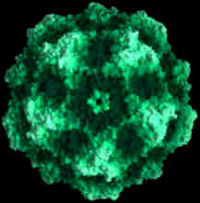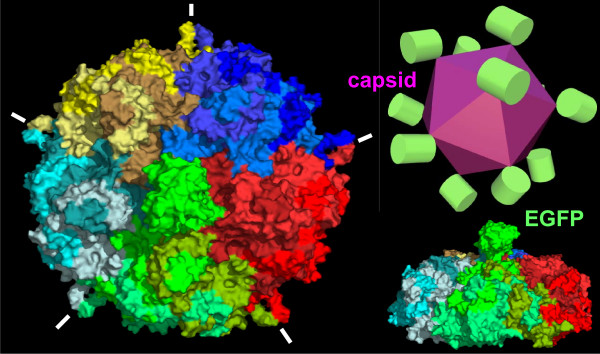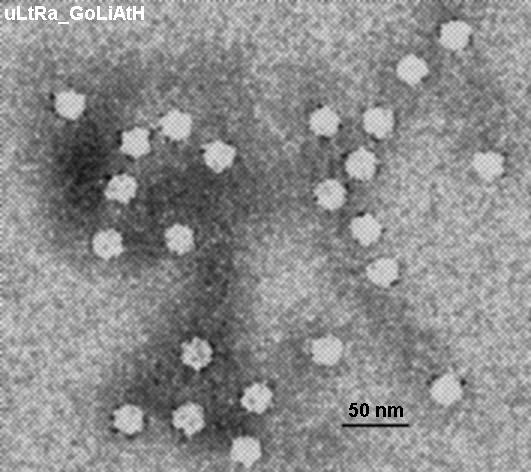Parvovirus: Difference between revisions
imported>Ronald Chew No edit summary |
imported>Ronald Chew No edit summary |
||
| Line 26: | Line 26: | ||
==Genome structure== | ==Genome structure== | ||
The genome of a canine parvovirus isolate strain (CPV-N) was cloned, and the DNA sequence was determined. The entire genome, including ends, was 5,323 nucleotides in length. The terminal repeat at the 3' end of the genome shared similar structural characteristics but limited homology with the rodent parvoviruses. The 5' terminal repeat was not detected in any of the clones. Instead, a region of DNA starting near the capsid gene stop codon and extending 248 base pairs into the coding region had been duplicated and inserted 75 base pairs downstream from the poly(A) addition site. Consensus sequences for the 5' donor and 3' acceptor sites as well as promotors and poly(A) addition sites were identified and compared with the available information on related parvoviruses. The genomic organization of CPV-N is similar to that of feline parvovirus (FPV) in that there are two major open reading frames (668 and 722 amino acids) in the plus strand (mRNA polarity). Both coding domains are in the same frame, and no significant open reading frames were apparent in any of the other frames of both minus and plus DNA strands. The nucleotide and amino acid homologies of the capsid genes between CPV-N and FPV were 98 and 99%, respectively. In contrast, the nucleotide and amino acid homologies of the capsid genes for CPV-N and CPV-b (S. Rhode III, J. Virol. 54:630-633, 1985) were 95 and 98%, respectively. These results indicate that very few nucleotide or amino acid changes differentiate the antigenic and host range specificity of FPV and CPV.<ref>Reed, Jones, and Miller. ''"Nucleotide sequence and genome organization of canine parvovirus."''J Virol. 1988 January; 62(1): 266–276.</ref> | |||
==Cell structure and metabolism== | ==Cell structure and metabolism== | ||
Revision as of 22:37, 16 April 2008
Articles that lack this notice, including many Eduzendium ones, welcome your collaboration! |
| Parvovirus | ||||||||
|---|---|---|---|---|---|---|---|---|
 | ||||||||
| Virus classification | ||||||||
|
Canine Parvovirus has two types. This article addresses only type-II. Canine parvovirus causes disease in animals, but not humans. Parvovirus B19, which causes various diseases in humans, is a member of the Erythrovirus genus of Parvoviridae rather than Parvovirus.
CPV-2 is a highly contagious virus affecting members of the family Canidae. Members would include domestic dogs, coyotes, wolves, and foxes. The virus is spread through direct or indirect contact with infected feces. Possible resevoirs for CPV-2 would include be shoes, paws, cages/carriers, and even soil. The virus can lie dormant on the ground for long periods of time (1+ years). It is resistant to much environmental conditions such as low pH and high temperatures.
Description and significance
Describe the appearance, habitat, etc. of the organism, and why it is important enough to have its genome sequenced. Describe how and where it was isolated. Include a picture or two (with sources) if you can find them.
Genome structure
The genome of a canine parvovirus isolate strain (CPV-N) was cloned, and the DNA sequence was determined. The entire genome, including ends, was 5,323 nucleotides in length. The terminal repeat at the 3' end of the genome shared similar structural characteristics but limited homology with the rodent parvoviruses. The 5' terminal repeat was not detected in any of the clones. Instead, a region of DNA starting near the capsid gene stop codon and extending 248 base pairs into the coding region had been duplicated and inserted 75 base pairs downstream from the poly(A) addition site. Consensus sequences for the 5' donor and 3' acceptor sites as well as promotors and poly(A) addition sites were identified and compared with the available information on related parvoviruses. The genomic organization of CPV-N is similar to that of feline parvovirus (FPV) in that there are two major open reading frames (668 and 722 amino acids) in the plus strand (mRNA polarity). Both coding domains are in the same frame, and no significant open reading frames were apparent in any of the other frames of both minus and plus DNA strands. The nucleotide and amino acid homologies of the capsid genes between CPV-N and FPV were 98 and 99%, respectively. In contrast, the nucleotide and amino acid homologies of the capsid genes for CPV-N and CPV-b (S. Rhode III, J. Virol. 54:630-633, 1985) were 95 and 98%, respectively. These results indicate that very few nucleotide or amino acid changes differentiate the antigenic and host range specificity of FPV and CPV.[1]
Cell structure and metabolism
Infectious virions of canine parvovirus contain 60 protein subunits that are predominantly VP-2. The central structural motif of VP-2 has the same topology (an eight-stranded antiparallel beta barrel) as has been found in many other icosahedral viruses but represents only about one-third of the capsid protein. There is a 22 angstrom (A) long protrusion on the threefold axes, a 15 A deep canyon circulating about each of the five cylindrical structures at the fivefold axes, and a 15 A deep depression at the twofold axes. By analogy with rhinoviruses, the canyon may be the site of receptor attachment. Residues related to the antigenic properties of the virus are found on the threefold protrusions. Some of the amino termini of VP-2 run to the exterior in full but not empty virions, which is consistent with the observation that some VP-2 polypeptides in full particles can be cleaved by trypsin. Eleven nucleotides are seen in each of 60 symmetry-related pockets on the interior surface of the capsid and together account for 13 percent of the genome.
Infection
Symptoms
Symptoms of intestinal form, know as enteritis, are depression, lethargy, loss of appetite, vomiting, fever, dehydration and bloody diarrhea. It may also include a lowering of white blood cell count, anemia and loss of protein. In the most severe case, shock and death can follow.
The cardiac form will not produce similar symptoms as the intestinal form. Since it attacks the heart muscle, a major sign is difficulty in breathing.
Ecology
Describe any interactions with other organisms (included eukaryotes), contributions to the environment, effect on environment, etc.
Pathology
How does this organism cause disease? Human, animal, plant hosts? Virulence factors, as well as patient symptoms.
Application to Biotechnology
Does this organism produce any useful compounds or enzymes? What are they and how are they used?
Current Research
Enter summaries of the most recent research here--at least three required
References
Megha Mathakia "PARVOVIRUS". 1998
- ↑ Reed, Jones, and Miller. "Nucleotide sequence and genome organization of canine parvovirus."J Virol. 1988 January; 62(1): 266–276.

